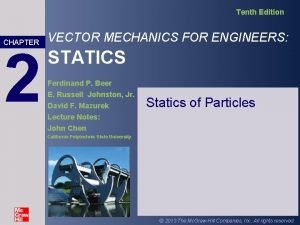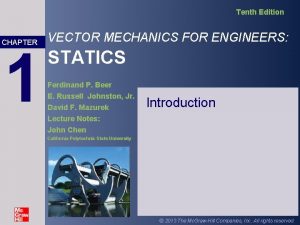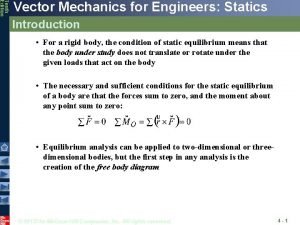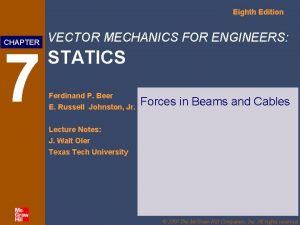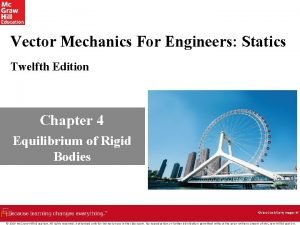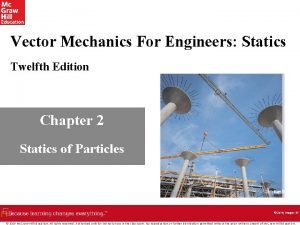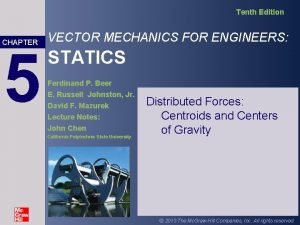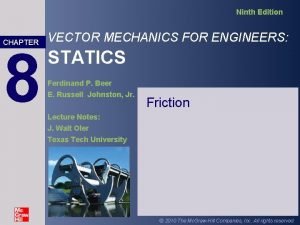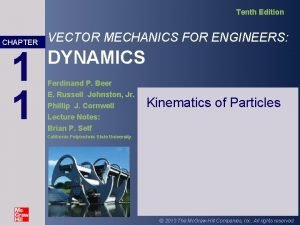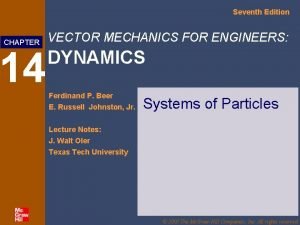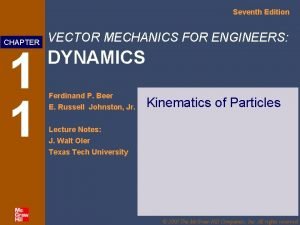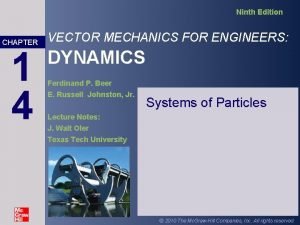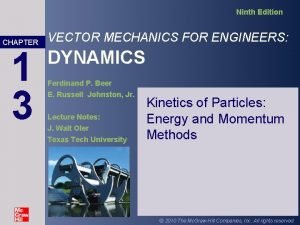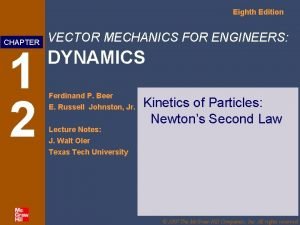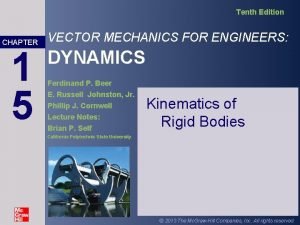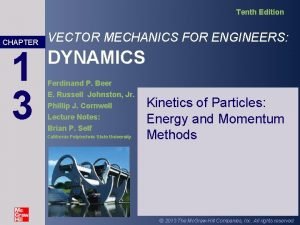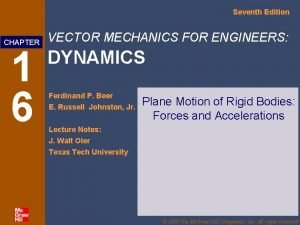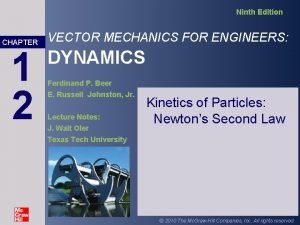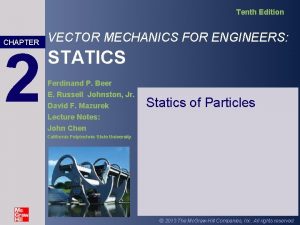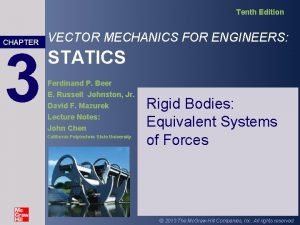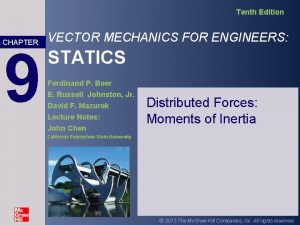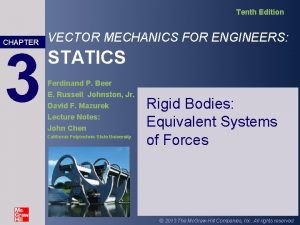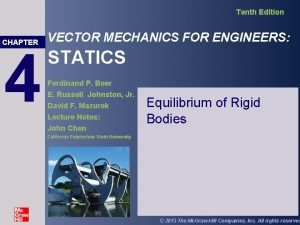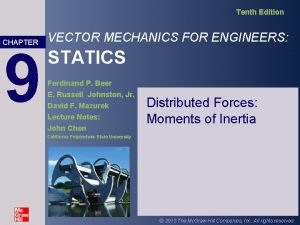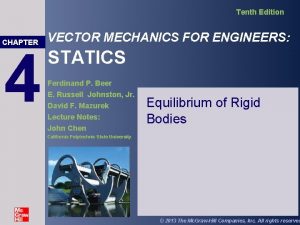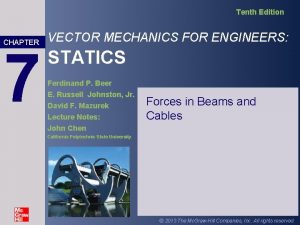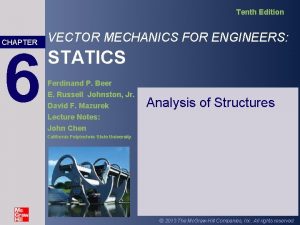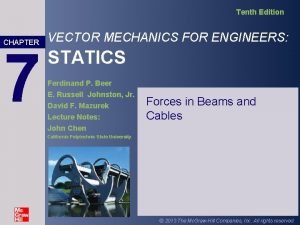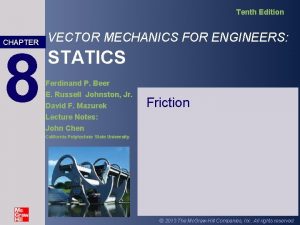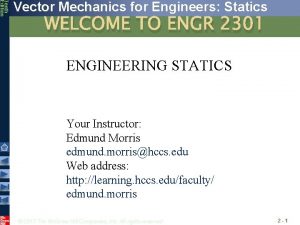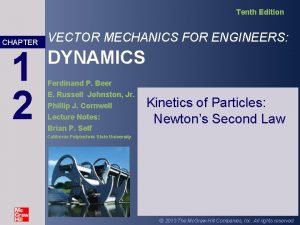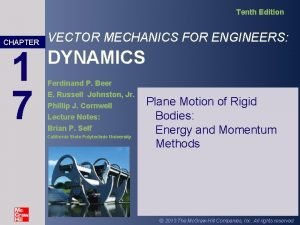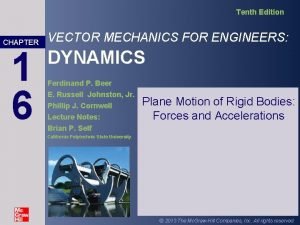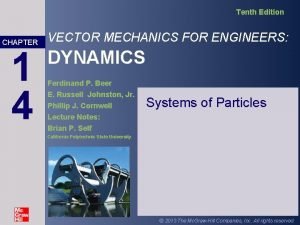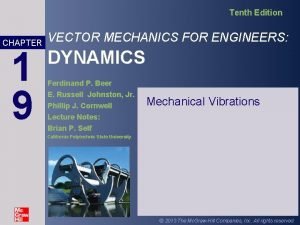Tenth Edition CHAPTER 4 VECTOR MECHANICS FOR ENGINEERS
































- Slides: 32

Tenth Edition CHAPTER 4 VECTOR MECHANICS FOR ENGINEERS: STATICS Ferdinand P. Beer E. Russell Johnston, Jr. David F. Mazurek Lecture Notes: John Chen Equilibrium of Rigid Bodies California Polytechnic State University © 2013 The Mc. Graw-Hill Companies, Inc. All rights reserved

Tenth Edition Vector Mechanics for Engineers: Statics Contents Introduction Free-Body Diagram Reactions at Supports and Connections for a Two. Dimensional Structure Equilibrium of a Rigid Body in Three Dimensions Reactions at Supports and Connections for a Three-Dimensional Structure Sample Problem 4. 8 Equilibrium of a Rigid Body in Two Dimensions Sample Problem 4. 1 Sample Problem 4. 4 Practice Statically Indeterminate Reactions © 2013 The Mc. Graw-Hill Companies, Inc. All rights reserved. 4 -2

Tenth Edition Vector Mechanics for Engineers: Statics Objectives By the end of this lesson you should be able to: 1) Analyze the static equilibrium of rigid bodies in two and three dimensions. 2) Draw complete and correct free-body diagrams. 3) Find reactions at supports and connections. 4) Examine rigid bodies supported by statically indeterminate reactions and partial constrains. © 2013 The Mc. Graw-Hill Companies, Inc. All rights reserved. 2 -3

Tenth Edition Vector Mechanics for Engineers: Statics Application Engineers designing this crane will need to determine the forces that act on this body under various conditions. © 2013 The Mc. Graw-Hill Companies, Inc. All rights reserved. 4 -4

Tenth Edition Vector Mechanics for Engineers: Statics Introduction • For a rigid body, the condition of static equilibrium means that the body under study does not translate or rotate under the given loads that act on the body • The necessary and sufficient conditions for the static equilibrium of a body are that the forces sum to zero, and the moment about any point sum to zero: • Equilibrium analysis can be applied to two-dimensional or threedimensional bodies, but the first step in any analysis is the creation of the free body diagram © 2013 The Mc. Graw-Hill Companies, Inc. All rights reserved. 4 -5

Tenth Edition Vector Mechanics for Engineers: Statics Free-Body Diagram The first step in the static equilibrium analysis of a rigid body is identification of all forces acting on the body with a free body diagram. • Select the body to be analyzed and detach it from the ground all other bodies and/or supports. • Indicate point of application, magnitude, and direction of external forces, including the rigid body weight. • Indicate point of application and assumed direction of unknown forces from reactions of the ground and/or other bodies, such as the supports. • Include the dimensions, which will be needed to compute the moments of the forces. © 2013 The Mc. Graw-Hill Companies, Inc. All rights reserved. 4 -6

Tenth Edition Vector Mechanics for Engineers: Statics Reactions at supports Why there must be a support (or supports)? Why there must be a reaction (reactions)? © 2013 The Mc. Graw-Hill Companies, Inc. All rights reserved. 2 -7

Tenth Edition Vector Mechanics for Engineers: Statics Types of reactions at supports https: //www. youtube. com/watch? v=qw. Fm. Xol 5 IXA © 2013 The Mc. Graw-Hill Companies, Inc. All rights reserved. 2 -8

Tenth Edition Vector Mechanics for Engineers: Statics Reactions at Supports and Connections for a Two-Dimensional Structure • Reactions equivalent to a force with known line of action. © 2013 The Mc. Graw-Hill Companies, Inc. All rights reserved. 4 -9

Tenth Edition Vector Mechanics for Engineers: Statics Reactions at Supports and Connections for a Two-Dimensional Structure • Reactions equivalent to a force of unknown direction and magnitude and a couple. of unknown magnitude © 2013 The Mc. Graw-Hill Companies, Inc. All rights reserved. 4 - 10

Tenth Edition Vector Mechanics for Engineers: Statics Practice The frame shown supports part of the roof of a small building. Your goal is to draw the free body diagram (FBD) for the frame. On the following page, you will choose the most correct FBD for this problem. First, you should draw your own FBD. © 2013 The Mc. Graw-Hill Companies, Inc. All rights reserved. 4 - 11

Tenth Edition Vector Mechanics for Engineers: Statics Practice B A 150 k. N Choose the most correct FBD for the original problem. B is the most correct, though C is also correct. A & D are incorrect; why? C 150 k. N Discuss with a neighbor why each choice is correct or incorrect. © 2013 The Mc. Graw-Hill Companies, Inc. All rights reserved. 4 - 12

Tenth Edition Vector Mechanics for Engineers: Statics Equilibrium of a Rigid Body in Two Dimensions • For known forces and moments that act on a two-dimensional structure, the following are true: • Equations of equilibrium become where A can be any point in the plane of the body. • The 3 equations can be solved for no more than 3 unknowns. • The 3 equations cannot be augmented with additional equations, but they can be replaced © 2013 The Mc. Graw-Hill Companies, Inc. All rights reserved. 4 - 13

Tenth Edition Vector Mechanics for Engineers: Statics Sample Problem 4. 1 SOLUTION: • Create a free-body diagram for the crane. • Determine B by solving the equation for the sum of the moments of all forces about A. Note there will be no contribution from the unknown reactions at A. A fixed crane has a mass of 1000 kg and is used to lift a 2400 kg crate. It is held in place by a pin at A and a rocker at B. The center of gravity of the crane is located at G. Determine the components of the reactions at A and B. • Determine the reactions at A by solving the equations for the sum of all horizontal force components and all vertical force components. • Check the values obtained for the reactions by verifying that the sum of the moments about B of all forces is zero. © 2013 The Mc. Graw-Hill Companies, Inc. All rights reserved. 4 - 14

Tenth Edition Vector Mechanics for Engineers: Statics Sample Problem 4. 1 • Determine B by solving the equation for the sum of the moments of all forces about A. • Create the free-body diagram. • Determine the reactions at A by solving the equations for the sum of all horizontal forces and all vertical forces. • Check the values obtained. © 2013 The Mc. Graw-Hill Companies, Inc. All rights reserved. 4 - 15

Tenth Edition Vector Mechanics for Engineers: Statics Sample Problem 4. 4 SOLUTION: - Discuss with a neighbor the steps for solving this problem • Create a free-body diagram for the frame and cable. The frame supports part of the roof of a small building. The tension in the cable is 150 k. N. • Apply the equilibrium equations for the reaction force components and couple at E. Determine the reaction at the fixed end E. © 2013 The Mc. Graw-Hill Companies, Inc. All rights reserved. 4 - 16

Tenth Edition Vector Mechanics for Engineers: Statics Sample Problem 4. 4 • Which equation is correct? A. B. C. • The free-body diagram was created in an earlier exercise. D. • Apply one of the three equilibrium equations. Try E. using the condition that the sum of forces in the x-direction • What does the negative signify? must sum to zero. • Discuss why the others are incorrect. © 2013 The Mc. Graw-Hill Companies, Inc. All rights reserved. 4 - 17

Tenth Edition Vector Mechanics for Engineers: Statics Sample Problem 4. 4 • Which equation is correct? A. B. C. • Now apply the condition that the sum of forces in the y-direction must sum to zero. D. E. • What does the positive signify? • Discuss why the others are incorrect. © 2013 The Mc. Graw-Hill Companies, Inc. All rights reserved. 4 - 18

Tenth Edition Vector Mechanics for Engineers: Statics Sample Problem 4. 4 • Three good points are D, E, and F. Discuss what advantage each point has over the others, or perhaps why each is equally good. • Assume that you choose point E to apply the sum-of-moments condition. Write the equation and compare your answer with a neighbor. • Finally, apply the condition that the sum of moments about any point must equal zero. • Discuss with a neighbor which point is the best for applying this equilibrium condition, and why. • Discuss with a neighbor the origin of each term in the above equation and what the positive value of ME means. © 2013 The Mc. Graw-Hill Companies, Inc. All rights reserved. 4 - 19

Tenth Edition Vector Mechanics for Engineers: Statics Practice A 2100 -lb tractor is used to lift 900 lb of gravel. Determine the reaction at each of the two rear wheels and two front wheels • First, create a free body diagram. Discuss with a neighbor what steps to take to solve this problem. • Second, apply the equilibrium conditions to generate three equations, and use these to solve for the desired quantities. © 2013 The Mc. Graw-Hill Companies, Inc. All rights reserved. 4 - 20

Tenth Edition Vector Mechanics for Engineers: Statics Practice • Draw the free body diagram of the tractor (on your own first). • From among the choices, choose the best FBD, and discuss the problem(s) with the other FBDs. B. A. FA 2100 lb FB C. FA 2100 lb FB D. FA 2100 lb FB © 2013 The Mc. Graw-Hill Companies, Inc. All rights reserved. 4 - 21

Tenth Edition Vector Mechanics for Engineers: Statics Practice Now let’s apply the equilibrium conditions to this FBD. • Start with the moment equation: FA 2100 lb FB Points A or B are equally good because each results in an equation with only one unknown. Discuss with a neighbor: • What’s the advantage to starting with this instead of the other conditions? • About what point should we sum moments, and why? © 2013 The Mc. Graw-Hill Companies, Inc. All rights reserved. 4 - 22

Tenth Edition Vector Mechanics for Engineers: Statics Practice Assume we chose to use point B. Choose the correct equation for FA 2100 lb FB FA=650 lb, so the reaction at each wheel is 325 lb © 2013 The Mc. Graw-Hill Companies, Inc. All rights reserved. 4 - 23

Tenth Edition Vector Mechanics for Engineers: Statics Practice Now apply the final equilibrium condition, SFy = 0. FA 2100 lb FB Why was the third equilibrium condition, SFx = 0 not used? © 2013 The Mc. Graw-Hill Companies, Inc. All rights reserved. 4 - 24

Tenth Edition Vector Mechanics for Engineers: Statics Statically Indeterminate Reactions • More unknowns than equations • Fewer unknowns than • Equal number unknowns and equations but equations, partially improperly constrained © 2013 The Mc. Graw-Hill Companies, Inc. All rights reserved. 4 - 25

Tenth Edition Vector Mechanics for Engineers: Statics Equilibrium of a Rigid Body in Three Dimensions • Six scalar equations are required to express the conditions for the equilibrium of a rigid body in the general three dimensional case. • These equations can be solved for no more than 6 unknowns which generally represent reactions at supports or connections or unknown applied forces. • The scalar equations are conveniently obtained by applying the vector forms of the conditions for equilibrium, © 2013 The Mc. Graw-Hill Companies, Inc. All rights reserved. 4 - 26

Tenth Edition Vector Mechanics for Engineers: Statics Reactions at Supports and Connections for a Three-Dimensional Structure © 2013 The Mc. Graw-Hill Companies, Inc. All rights reserved. 4 - 27

Tenth Edition Vector Mechanics for Engineers: Statics Reactions at Supports and Connections for a Three-Dimensional Structure © 2013 The Mc. Graw-Hill Companies, Inc. All rights reserved. 4 - 28

Tenth Edition Vector Mechanics for Engineers: Statics Sample Problem 4. 8 SOLUTION: • Create a free-body diagram for the sign. • Apply the conditions for static equilibrium to develop equations for the unknown reactions. A sign of uniform density weighs 270 lb and is supported by a ball-andsocket joint at A and by two cables. Determine the tension in each cable and the reaction at A. © 2013 The Mc. Graw-Hill Companies, Inc. All rights reserved. 4 - 29

Tenth Edition Vector Mechanics for Engineers: Statics Sample Problem 4. 8 • Create a free-body diagram for the sign. Since there are only 5 unknowns, the sign is partially constrained. All forces intersect with the x-axis, so SMX=0, so this equation is not useful to the solution. © 2013 The Mc. Graw-Hill Companies, Inc. All rights reserved. 4 - 30

Tenth Edition Vector Mechanics for Engineers: Statics Sample Problem 4. 8 • Apply the conditions for static equilibrium to develop equations for the unknown reactions. Solve the 5 equations for the 5 unknowns, © 2013 The Mc. Graw-Hill Companies, Inc. All rights reserved. 4 - 31

Tenth Edition Vector Mechanics for Engineers: Statics What if…? Could this sign be in static equilibrium if cable BD were removed? Discuss with your neighbor, and be sure to provide the reason(s) for your answer. The sign could not be in static equilibrium because TEC causes a moment about the y-axis (due to the existence of TEC, Z) which must be countered by an equal and opposite moment. This can only be provided by a cable tension that has a z-component in the negative-z direction, such as what TBD has. © 2013 The Mc. Graw-Hill Companies, Inc. All rights reserved. 4 - 32
 Mechanics for engineers
Mechanics for engineers Vector mechanics for engineers statics 10th edition
Vector mechanics for engineers statics 10th edition Vector mechanics for engineers
Vector mechanics for engineers Vector mechanics for engineers statics 10th edition
Vector mechanics for engineers statics 10th edition Vector mechanics for engineers chapter 7 solutions
Vector mechanics for engineers chapter 7 solutions Static equilibrium
Static equilibrium What is line of action
What is line of action Vector mechanics for engineers
Vector mechanics for engineers Vector mechanics for engineers
Vector mechanics for engineers Vector mechanics for engineers: dynamics
Vector mechanics for engineers: dynamics Vector mechanics for engineers: dynamics
Vector mechanics for engineers: dynamics Vector mechanics for engineers dynamics 12th
Vector mechanics for engineers dynamics 12th Vector mechanics for engineers: dynamics
Vector mechanics for engineers: dynamics Vector mechanics for engineers: dynamics
Vector mechanics for engineers: dynamics Vector mechanics for engineers: dynamics
Vector mechanics for engineers: dynamics Overall expression
Overall expression Vector mechanics for engineers dynamics 12th
Vector mechanics for engineers dynamics 12th Vector mechanics for engineers dynamics 12th
Vector mechanics for engineers dynamics 12th Vector mechanics for engineers dynamics 12th
Vector mechanics for engineers dynamics 12th Campbell biology tenth edition
Campbell biology tenth edition Campbell biology tenth edition
Campbell biology tenth edition Campbell biology tenth edition
Campbell biology tenth edition Elementary statistics tenth edition
Elementary statistics tenth edition Digital fundamentals floyd 10th edition
Digital fundamentals floyd 10th edition Corporate finance tenth edition
Corporate finance tenth edition Psychology tenth edition david g myers
Psychology tenth edition david g myers Human genetics concepts and applications 10th edition
Human genetics concepts and applications 10th edition Corporate finance tenth edition
Corporate finance tenth edition Corporate finance tenth edition
Corporate finance tenth edition Corporate finance tenth edition
Corporate finance tenth edition Corporate finance tenth edition
Corporate finance tenth edition Campbell biology tenth edition
Campbell biology tenth edition Biology tenth edition
Biology tenth edition
